A Computer Aided Approach for River Styles—Inspired Characterization of Large Basins: A Structured Procedure and Support Tools
Abstract
1. Introduction
- ◦
- The Riverscapes consortium https://www.riverscapes.xyz/, a collaboration between fluvial researchers in the United States of America, United Kingdom, New Zealand, Australia, Italy, France, and Spain, particularly with its ToolBox RCAT (http://rcat.riverscapes.xyz/), which includes: the Valley Bottom Extraction Tool (V-BET), the Riparian Vegetation Departure (RVD) tool, the Riparian Condition Assessment (RCA) tool, and the Riparian Recovery Potential (RRP) tool.
- ◦
- The Valley Bottom Confinement Tool (VBCT), developed and based on studies by Fryirs et al. [4,5] and O’Brien et al. [6] (http://confinement.riverscapes.xyz/).
- ◦
- The TerEx ToolBox (terrace and floodplain mapping), based on the work of Clubb et al. [7] and Stout and Belmont [8] (https://qcnr.usu.edu/labs/belmont_lab/resources).
- ◦
- The Fluvial Corridor ToolBox (FCT), by the group led by Hervé Piégay at the University of Lyon (France); currently, they are developing a version within the QGIS 3.x interface compiling scripts written in Python (https://github.com/tramebleue/fct).
- ◦
- The River Meandering Migration Software (RVRMeander; http://www.rvrmeander.org/) of the University of Illinois, University of Pittsburgh, and USDA(U.S. Department Of Agriculture), with applications in particular to the Amazon River by Jorge Abad.
- ◦
- The Geomorphic Unit Tool (GUT), which delineates instream geomorphic units (GUs) from topography using a three-tiered hierarchical classification adapted from Wheaton et al. [9] (http://gut.riverscapes.xyz/).
2. Systematizing a River Styles Inspired Characterization–Classification Exercise
- (a)
- Modifying the Procedural Tree, by “locating first what weighs more”, in such a way that a hierarchical classification can be obtained that can manage all sub-types generated in particular by the assemblage of the different geomorphological units (which can give rise to a large number of sub styles).
- (b)
- Identifying objectively the (variable length) reaches according to the spatial intersection of only the set of intensive-type attributes of the Procedural Tree (i.e., those not depending on the extension of the length of the considered segment) and assessing all the extensive-type attributes as spatial statistics over such reaches. This idea is further explained in [16,17,18].
- (c)
- Relying on a spatial database (called “skeleton”) obtained by segmenting the valley bottom in sub-segments along its axis, and determining a value for each relevant attribute in each sub-segment.
- (d)
- Specifying a set of tools that ensure the ability to also deal with large river systems. The proposed tools (Appendix A) are a particular choice out of a virtually infinite (or at least quite large) number of alternatives; but having defined at least a tool set that does cover all the demanding steps (elaborations of extensive information and computational steps) brings in an added value as, without them, several snags might prevent a candidate user from applying the RS approach.
- (e)
- Proposing a sequence of operations that covers the whole exercise, ensuring a linkage amongst steps and avoiding redundancies.
3. New Tools/Procedures
3.1. Confinement
- (i)
- reaches (as usually done in the RS);
- (ii)
- basin scale (macro): indeed, it is possible to adopt a very simple and effective criterion to identify macro segments, e.g., where a significant change of VB width (V) occurs (a fact that can be detected by the Hubert Test in the FCT or simply...visually) and the resulting macro confinement is very meaningful (Figure 3).
- ◦
- it determines the contacts—both margins—between active channel and “inflated” (buffer) VB margin through a GIS intersection;
- ◦
- these contacts are projected onto the reference axis with a binary value (0 for no contact; 1 for contact at either bank);
- ◦
- the axis is discretized in “short-segments” (identified by k) of a pre-fixed length;
- ◦
- the algorithm goes on by computing locally (for each slice) the statistical indicator c(k) as the total length of the projected contacts (either banks) falling in it, over the segment length;
- ◦
- finally, it assumes that when the indicator c(k) is 0.50 < c(k) < 0.85 the cause of confinement is the valley margin, while when it is 0.10 < c(k) < 0.50 the cause is a planform geomorphic unit.
- ◦
- it is accessible to any user of ArcGIS (or QGIS) and Excel;
- ◦
- it computes an explicit statistical confinement indicator;
- ◦
- it determines the cause of confinement, if provided with the polyline of the VB margins separated in categories: valley margin, planform, or infrastructure.
3.2. A Logical Heuristic “Reductionist→ Holistic Algorithm” for Mono-Dimensional Variables
3.2.1. Reductionist → Holistic Algorithms: The Literature Status
3.2.2. Reductionist→ Holistic Algorithm: The Binary Case
- ◦
- choose a significant minimum river length LS, basically according to the usual criterion of LS = 10 ÷ 20 W, where W is the width of the envelope of active channels. This minimum length corresponds to a number K of segments (K = Ls/d, with d length of a discretization segment) and their associated values of the considered variable;
- ◦
- identify the discontinuity points, i.e., locations where the binary indicator (measuring the relevant attribute) changes from 0 to 1 or vice versa, and determine the distance D(-1) from the previous discontinuity (the notation D(-n) denotes the number of points separating previous discontinuity from the segment located n steps before current one);
- ◦
- if the current point is not a discontinuity, then just keep the original value of the variable; if it is a discontinuity, instead, “look forward and backwards” to ascertain whether the discontinuity is due just to a local effect (“absence’, i.e., a “hole”, or “presence”) or it is the beginning of a new reach within the significant horizon, and assign the new value accordingly (see Figure 8).
- →
- All of this results in a sequence of value for the new binary variable (0,1) “presence” called “Holistic 1”.
- ◦
- identify new discontinuities for this new variable;
- ◦
- to each one, apply a forward moving averaging (on the K horizon) operator and, if the result is less than the threshold α, come back to a 0 value (absence), otherwise set it to 1;
- ◦
- in this way, obtain a sequence of values for the new binary variable “presence” called “Holistic 2”;
- ◦
- in this series, filter out all reaches characterized by absence, but shorter than the minimum significant length LS;
- ◦
- obtain thus a sequence of values for the new binary variable “presence” called “Holistic 3”;
- ◦
- in this series, filter out all reaches characterized instead by presence, but shorter than the minimum significant length.
- →
- Result is the final sequence of values for the binary variable called “Holistic ok”.
3.2.3. Binary Case: Application to Magdalena River’s Islands
3.2.4. Reductionist→ Holistic Algorithm: The Categorical Case
- ◦
- Identify discontinuities (where switches from one category to any other occur).
- ◦
- Where no discontinuity is present, the algorithm keeps the previously calculated value (as a result of this holistic algorithm; at the first step it assumes the original value).
- ◦
- Where a discontinuity occurs:
- -
- “K steps forward prevailing”: the algorithm identifies that category which occurs with the highest frequency in the K steps downstream.
- -
- "Residual frontal window": analogous, but along just K–D(-1) steps forward (this is a forward moving horizon which progressively narrows down within a fixed window starting from the previous discontinuity; it is modified when a switch occurs to the next discontinuity). Its purpose is to consider what the prevailing value was previous to the current point.
- -
- When the prevailing value in the residual forward window coincides with that previous to the last discontinuity → current segment is just a “local hole” and as such the algorithm keeps the previous holistic value.
- -
- When the value is "not detectable" (one of the 7 possible categories), the algorithm just keeps it.
- -
- If not, the algorithm takes the same value of the prevailing category within the K steps forward.
- -
- It identifies the discontinuities in the result from Cycle I.
- -
- If the full distance from the previous discontinuity is smaller than K, the algorithm assigns the same value occurring before the discontinuity.
- -
- If not, it keeps the current value.
4. Conclusions
Author Contributions
Funding
Acknowledgments
Conflicts of Interest
Appendix A
| Object | Algorithm | Tool/Procedure | Observations | |
|---|---|---|---|---|
| Methodology | Procedural Tree and definition of attributes | Choose structure suited for the case at hand conserving a river basin (or even better, a regional) perspective | Expert judgement | This is where expert judgment is mainly involved |
| Instrumental | DEM clipped to the area of interest | Select and extract zone of interest | Manual: ArcGIS TOOL CLIP (Data Management) according to a rectangle mask or EXTRACT by MASK, given a polygon (i.e., the river basin) | |
| Instrumental | Landforms (terraces, fans…) | Expert judgement (from aerial photographs, field surveys, …) | Manual | With a high-resolution DEM some degree of automation is possible (e.g., TerEX by Stout and Belmont, [8]) |
| Instrumental | GIS reference points | Locate points along the axis of VB (see below) at constant distance | Standard GIS procedures (creating points along a line) | These are very useful to orient the analyst while quickly switching from GIS to Google Earth |
| Instrumental | Geographical reference points | Expert judgement (towns, known sites, appropriate density, closeness to river, manageable number, etc.) | Manual construction of a point GIS Shapefile (SHP) | Sites useful to guide descriptions and to show in schematics and maps |
| Instrumental | Base segmentation points | Location where there is an evident change of VB width, catchment area (tributary); break in slope; discontinuities (dams) | Manual standard GIS procedures. Possibly use FCT: Disaggregation; Metrics (width, etc.), Statistics (Hubert’s test) and Metrics (Discontinuities) | Can be used as a preliminary indication to define reaches (e.g., VB width well identifies macro reaches) |
| Instrumental | Type of VB margin | Identification of infrastructure and landform mapping | Manual by standard GIS procedures | First the effective valley bottom must be defined (see below) |
| Instrumental | Contact points river-valley margin | Identify key points where the envelope of active riverbed (see below) touches the margin of the effective VB. Geological, planform, and anthropogenic contacts should be considered | Manual, expert judgment procedure on GIS supported by DEM info + standard construction of a GIS point SHP (semi-automatic GIS algorithms are an alternative) | Useful to assess degree of "constraint" and sediment sources, particularly in laterally unconfined (but constrained) reaches. Active channels’ envelope needs to be determined first (see below) |
| Instrumental | Contact segments between active riverbed and VB margins | Create a thin buffer around the envelope of the active riverbed; then intersect with the effective VB (see below) | Manual standard ArcGIS procedures (buffer, intersection) | It is a basic information for the confinement attribute. Active channels’ envelope must be determined first (see below) |
| Instrumental | Sediment sources | Identify where there is: a contact point with landslides, fans or terraces; or meanders with external VB elevation higher than internal (so that the erosion-sedimentation balance is positive); or a tributary input | Manual (expert based) or semi-automated GIS procedures | The expert judgment can be synthesized in a logical tree that can then be implemented (even in an Excel spreadsheet) to carry out this task |
| Instrumental | Constrictions | Identify where:-VB is narrow: (V-W local)/W < α-the reach is single thread and not excessively "spread"; i.e.,: [ W–w]/w < β -The envelope significantly reduces with respect to the upstream average: [W–W ]/W > γ. Where: CA: active river bed (set of active channels); V: VB width (and V: moving average); W: width of envelope (W: moving average); w: width of active river bed; and: α,β,γ: parameters. | Excel spreadsheet (GeoMagdaToolBoxManual: "Esqueleto_magda") | A constriction is not a contact point, but a short reach where the VB narrows down significantly, at the local scale, as compared with upstream and downstream. Constrictions are important because they can induce changes in hydraulic and sediment behavior and, consequently, in morphology |
| Instrumental | Segmented VB | Spatial discretization of the VB according to regular reaches along its centerline with a relatively fine step (e.g., 500 m for the Magdalena) and sequenced (i.e., spatially ordered) | FCT: Disaggregation; Sequencing | This is a very important step that supports several subsequent steps. The key output is the “Rank_DGO” field of the obtained table. |
| Geomorphic elements | Active channel “just water” | Satellite images interpretation. For Magdalena: use of official SHP IGAC 100 mil “Drenaje doble” already available; separation of branches not completely connected and tributaries | -ArcGIS procedure: calculation of indices like MNDWI (the Modified Normalized Difference Water Index) [30,31], selection of pixels over threshold, transformation to polygon, cleaning-Manual, expert judgment in ArcGIS | It is important to use images referring to high waters, but actual overbank flooding should be avoided. Automatic algorithms suffer from presence of clouds |
| Geomorphic elements | Active riverbed (CA) (collection of active channels completely connected, including bars, but not islands) | Add mid channel and bank attached bars to the "active channel just water” polygon. NOTICE: The procedure presented here refers to the specific information available for the Magdalena, where an official SHP IGAC 1:100,000 was available for bars ("bancos de arena") but did not discriminate amongst main river and tributaries. It must be noted that this SHP presents some inconsistencies; it was probably built based on different, asynchronous images, possibly by different operators. | ArcGIS procedure: -draft (still without bars) envelope of active channels (see next step); -buffer of this envelope of a max width of lateral bar; -CLIP the original bars SHP (IGAC 2017 100 mil «bancos de arena») with this envelope; -manual check to eliminate bars not belonging to the river of interest; -MERGE with the active river bed; DISSOLVE | Care must be put in not including bars belonging to tributaries; there is a degree of ambiguity. A more direct procedure consists of identifying bars directly from satellite images as bare surfaces, based for instance on the SWIR (Short-wavelength infrared) band (band 7 in OLI (The Operational Land Imager), TIRS (Thermal Infrared) and TM (Thematic Mapper) Landsat missions), as shown in Monegaglia et al. [32] |
| Geomorphic elements | Envelope of active riverbed (collection of connected active channels) | Transform the polygon into a polyline SHP and eliminate all lines different from the external boundary | ArcGIS procedure:-Tool «Feature to Line»; -manually eliminate internal small polygons; -retransform into a polygon with «Feature to Polygon»; -finally, possibly use «Smooth Polygon» (Cartography) | This is not a "convex hull", but the polygon ideally obtained by merging the polygons of all active channels fully connected |
| Geomorphic elements | Islands | Eliminate the active riverbed (including bars) from the envelope of active riverbed | ArcGIS: ERASE | Alternatively, interpretation of satellite images with appropriate indices (e.g., NDWI, Carlson and Ripley, [33]) can be carried out. However, the procedure suggested here ensures consistency |
| Geomorphic elements | Bank-attached bars | Eliminate the envelope of active riverbed "just water" (which, by construction, includes islands and mid channel bars) from the envelope of active riverbed (CA) | ArcGIS: ERASE | Alternative methods exist; for instance, the GUT tool within the River Scape Community ([34,35,36]), but they just work with high resolution imagery and altimetry. UAV surveys can provide viable alternative at moderate scales of analysis (e.g., Casado et al. [12] or for a review: Carrivick and Smith, [3]) |
| Geomorphic elements | Mid-channel bars | Eliminate the active riverbed "just water" and island sand bank attached bars from the envelope of active riverbed | ArcGIS: ERASE triple | Same observation as above |
| Geomorphic elements | Axis of active riverbed | Centerline of the envelope of active riverbed | -FCT (Tool 1.3 Centerline), or ToolBox Manual (Módulo Básico 2): tool based on ArcGIS/ArcScan which provides a more smoothed output-PyRIS proposed by Monegaglia et al. [32]: the tool identifies the axis of the main channel even in anabranching rivers, defined either as the widest or the longest | For RS application, a centerline is sufficient and perhaps preferable because in anabranching rivers, selecting a particular branch may be less representative. |
| Geomorphic elements | Natural valley bottom (VB) | Identify the portion of flat land adjacent to the river and not higher than a given threshold. Build to this aim various DEM of Differences (DoD) with various thresholds and check consistency with land-use, envelope of contemporary flooded areas (e.g., from the Dartmouth Flood Observatory database: https://www.dartmouth.edu/~floods/, specifically the derived product “Annual flooded areas”), geomorphic map, field evidences | FCT: Spatial Components; 1.2 valley bottom. See however various details explained in the ToolBox Manual, "Modulo VB". Other tools exist like for instance VBET [37], but with no particular advantages | Even with a perfect DEM, a manual correction is needed because of several reasons, e.g., the DEM may have captured the elevation of water, not of riverbed and hence the DoD is at least ambiguous. |
| Geomorphic elements | Effective VB | Eliminate from Natural VB portions separated by works that may interrupt channel migration or flooding (e.g., roads, railways, rip-rap protections) | Manual procedure in ArcGIS. In the ToolBox Manual, "Modulo Básico 8", a systematic procedure is proposed | - |
| Geomorphic elements | Axis of effective VB | Centerline of the envelope of effective valley bottom | Totally analogous to "Axis of active riverbed" | - |
| RS Attributes | Sediments (bed material texture) | Construction of a point SHP in each sampling or survey station and transformation to a line SHP (based on the Axis of Active Channel) assuming some interpolation criterion | -Physically sample or adopt some imagery interpretation tool (e.g., [38,39]) -Interpolation: assume that the sampled texture holds until next station, possibly with expert-judgment adjustments; or: use an algorithm to translate reductionist information into a holistic synthesis like the "HOLISTICO binario" Excel Tool | - |
| RS Attributes | Planform | Identify reaches with a recognizable combined pattern of number of channels, distance, width, sinuosity and number, size and position of islands and bars. | -Expert-based identification based on satellite imagery (e.g., Google Earth) and available polygons of active riverbed. Supported by ToolBox Manual: “Modulo FCT 3.4 Morphometry” for sinuosity and “Modulo sinuosidad nueva”; “Modulo MonoMulti canales” for single/multi thread (see this paper). -Alternatively, use the automated Excel tool presented in Nardini et al. [16] | a-Single thread: rectilineous, sinuous, meandering, irregular, tortuous. b-Transitional: wandering; alternate bars; “swallowing” (i.e., still single thread and mainly straight or sinuous, with local significant widening, including one or more islands. c- Multi thread: braided; island braided; anabranching avulsive; anastomosed; combinations. |
| RS Attributes | Streamflow character | Identify reaches with a recognizable pattern of current threads, turbulence, areas of still water. (for rivers where the riverbed is visible at low flow, a similar attribute would be “bed morphology”) | -Expert judgement or - Other Tools like GUT (see above) -interpolate with reductionist-holistic “HOLISTIC categorical” Excel Tool | Google Earth imagery brings in ambiguities because of varying quality, date and time of the images. |
| RS Attributes | Presence of natural levees | Identification of elements from aerial or satellite imagery (e.g., Google Earth) and DEM; holistic synthesis of the reductionist information into meaningful stretches; translation reporting into a polyline along active riverbed axis with binary attribute (presence/absence) | Expert judgement + info from existing reports → construction of a polygon SHP Then: GIS intersection of such SHP with the segmented effective VB (from FCT); translation into a binary attribute (presence/absence) along the discretized VB axis (GIS procedure); finally, translation into a polyline (presence/absence) along the VB axis with the “ HOLISTICO binario” Excel Tool (see above); possibly, transposition into a polyline along the axis of the active river bed with the Excel Tool “De_VB_a_CA” | For the first step of identification, alternatively, GUT Tool or similar can possibly be used. The transposition from the discretized VB axis into the axis of the active river bed is not trivial because, owing to their different location in the floodplain, a different number of segments from discretization may occur. All this is explained in detail in the ToolBox Manual (Modulo Basico 5 and 6) |
| RS A. | Presence of wetlands | analogous | analogous | analogous |
| RS A. | Presence of paleo channels | analogous | analogous | analogous |
| RS A. | Presence of oxbows | analogous | analogous | analogous |
| RS A. | Presence of ridge & swale topography | analogous | analogous | analogous |
| RS A. | Presence of bank-attached bars | analogous | analogous | analogous |
| RS A. | Presence of mid-channel bars | analogous | analogous | analogous |
| RS A. | Presence of islands | analogous | analogous | analogous |
| RS Attributes | Confinement | Identification of contact lengths (see above) and computation of a statistic indicator over the reaches of the selected segmentation | Manual ArcGIS procedure as detailed in the ToolBox Manual Modulo 3 bis (this paper) | Confinement is a statistical indicator defined over an ordinal scale, assessed for each reach, with values: “confined”, “partly confined”, “laterally unconfined” |
| RS Attributes | Cause of confinement | For each confined or partly confined reach, identifies which is the prevailing cause amongst: “valley”, “planform”, “works” (anthropogenic) | Manual ArcGIS procedure as detailed in the ToolBox Manual Modulo 3 bis (this paper) | In each reach, several causes may intervene; the prevailing one in terms of lengths involved (adding right and left bank) is considered |
| RS A. | Constraints | Expert judgement based on the contact points already identified | Manual on ArcGIS | |
| Synthesis | Reaches | According to Nardini et al. [16], we identify independent segments according to non-extensive attributes: Planform; Bed material texture; Streamflow character, finding the “least common, spatial denominator” | (see Nardini et al. [18]) | The reaches are the basis for the Geo database and to support visualization of attributes |
| Synthesis | GeoDB (polyline GIS SHP segmented according to reaches) | Assign to each reach a value for each one of the relevant attributes. For those directly involved in the definition of reaches, just select the appropriate value associated with the original segmentation; for the remaining ones (belonging to the Procedural Tree), compute a statistic, ordinal indicator (e.g., for binary cases like local presence/absence of a geomorphic unit: 1: “absent”, 2: “occasional”, 3: “frequent”, 4: “prevailing”, 5: "complete”) | For: Cause of confinement: see Excel Tool “CONFINA” in the ToolBox Manual. For binary attributes it is the % of reach length where the attributes presents a “YES” value: see Excel Tool ESTADIS_Tramos | According to our Procedural Tree, the attributes requiring a statistical computation are:-confinement-cause of confinement-geomorphic units within the VB (levees, oxbow, ridge and swale, paleoCH, wetlands)-geomorphic units within the channels (bank attached and mid channel bars, islands; streamflow character) |
| Synthesis | Skeleton (finely discretized, polyline GIS SHP) | Discretize the VB axis in short segments (e.g., 500 m for the 1400 km long VB axis of the Magdalena River); compute a metric for each attribute relevant to generate a meaningful synoptic scheme (distances, elevation, contributing catchment area; active river bed width, VB width, valley slope); build an area- bankfull flowrate relationship (Qb = Qb(A)) and determine total and specific streampower | FCT: 3. Metrics (in each segment, the Tool computes several values, e.g., every 50 m within a 500 m segment, and offers sub-statistics) | Skeleton is better constructed along the axis of the valley bottom in order to represent planform sinuosity. In the Magdalena exercise, owing to the low DEM resolution, FCT did not work to determine the contributing catchment area; a manual ArcGIS procedure was adopted instead and then data were processed within the Excel “Tool ESQUELETO” |
| Synthesis | Synoptic scheme (profile and plan view) | Build a sketch in Excel (both profile and plan view) by using the Skeleton information and reference points SHP. | A suitable filter (e.g., moving average plus not decreasing condition) must always be applied to the original elevation data from DEM, particularly when referring to the VB axis because this is an idealized line that often crosses planforms or hills (an example is offered in the Excel Tool ESQUELETO) | There must be one for each river considered in the basin (in our preliminary exercise Magdalena and Cauca rivers). It is appropriate to include in the main river sketch (Magdalena) the long profile for all tributaries |
| Synthesis | Macro scale map | Map the relevant information (possibly available from existing cartography): landscape units, faults involving the rivers; active channels; reference points; effective VB; macro scale confinement; planform (or at least single-multi thread segments); cause of confinement (VB margins); constrictions | Standard ArcGIS mapping procedures | All relevant rivers are presented in a same map. This is split into a minimum number of whole basin maps because merging too much information is confusing; so, the clearest, but most synthetic combination must be sought |
| Classification | River Styles | Identify the reaches with the same combination of values of main attributes, according to the Procedural Tree adopted (e.g., planform, bed material texture, confinement, cause of confinement); do the same with all attributes. | Python/ArcGIS Tool (ToolBox Manual): see ToolBox Manual and Nardini et al. [16,17] | Owing to ArcGIS limitations, currently it supports only 7 attributes at a time; therefore, the process might need to be split in more than just two cycles. Actually, we needed three for the Magdalena:I cycle: main ones → Label Main II cycle: Label Main + 5 geomorphic units within the VB → Label II. III cycle: Label_II + 4 geomorphic units within the channel |
Appendix B
Appendix B.1. B—Determining Confinement
- (i)
- Identify local confined segments (contact between the AC envelope and VB margins, analogously to O’Brien et al. [6]):
- -
- create a small buffer of the AC envelope (delta = 10 ÷ 20 m for the Magdalena; this is a parameter to be “calibrated” according to the river at hand);
- -
- apply “ERASE tool” of the output polygon with the VB polygon → the output is a SHP of small «contact» polygons (it is possible to transform them into lines, but it is not necessary);
- -
- apply “BUFFER tool” of such contact polygons with the same delta (set ArcGIS options as: Side type = FULL and Dissolve = NONE);
- -
- add an integer field (CONF);
- -
- separate the right from the left part by ERASE using two masks defined from the AC axis: use Right Mask for left part and vice versa.
- (ii)
- Determine a local confinement indicator within the Skeleton, by using the spatial correspondence between contact segments and discretization “slices” obtained for instance with the Fluvial Corridor ToolBox (see Table A1) to this aim:
- -
- apply “Spatial Joint tool” of the contact segments (polygons), first left and then right, with the effective, segmented VB (and sequenced, i.e., with a spatial order, output of a FCT tool which automatically includes the “Rank_DGO” field) as target;
- -
- assign (with Select by attribute and field calculator) 1 if there is no empty intersection (i.e., there is local confinement) or 0, if vice versa;
- -
- thus, obtain the segmented VB with the binary 0-1 field for confinement (two polygon SHP for left and right sides). What is useful in this SHP table is the “CONF” columns;
- -
- extract the SHP table in an Excel spreadsheet; Sort on the basis of the Rank_DGO field;
- -
- apply “PASTE tool” in it these two columns (one at a time) and the Rank_DGO column (the Excel Tool CONFINA can be used for this purpose).
- (iii)
- obtain the final statistical indicator over the selected reaches (polyline SHP “Reaches” with final segmentation chosen to assess confinement); notice that such reaches typically have varying lengths. The statistical indicator can simply be the ratio of the total number of either bank confined slices falling within a reach, over the total number of slices within that reach. To this aim:
- -
- insert a field “ID_Reach” into the table of the .shp Reaches, with-increasing value;
- -
- apply “Spatial Join tool” of the segmented SHP VB with this .shp Reaches (using VB as Target to obtain a complete correspondence of elements);
- -
- export the table and correct manually because, once ordered base on the Rank_DGO field, “holes” may appear (i.e., “0” values in the middle of a sequence of a given value corresponding to a long segment: this is caused by the fact that the axis of the AC may not intersect all the elements of the VB, as shown in Figure A1) in the ID_Tramos column: these must be filled. In this way, this instrumental Excel will now contain two fields (say “CONF_sx” and “CONF_dx”) with the correspondence of elements between Skeleton (discretization “slices”) and reaches;
- -
- in the same Excel it is now possible to compute the statistical indicator: The final product is a polyline SHP Reaches including a discrete attribute with (typically) the three categories “confined, partly confined, laterally unconfined”.
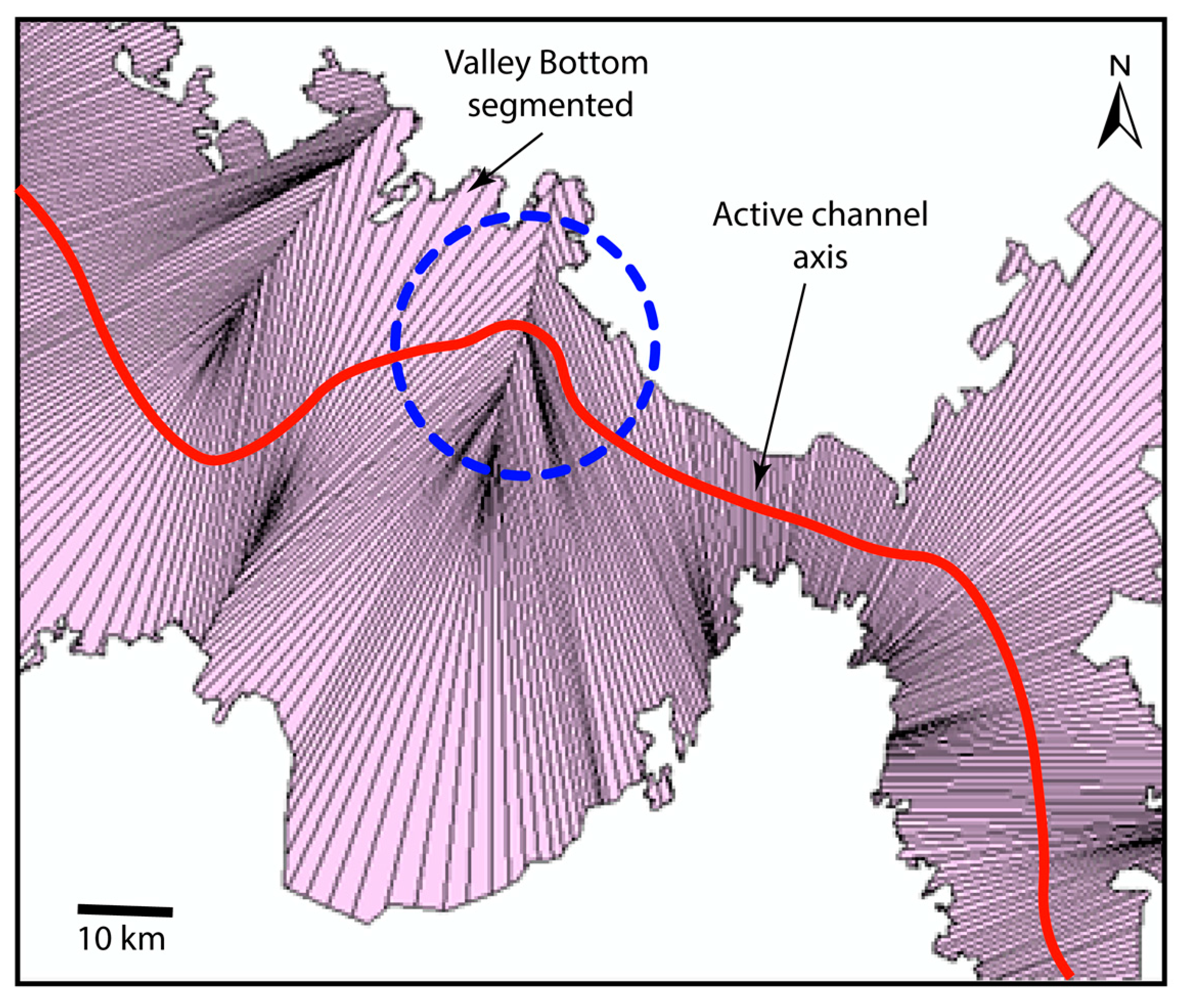
Appendix B.2. B—Determining the Cause of Confinement
- (1)
- Build a VB margin polyline SHP with an attribute "Type of margin" (valley, planform, and infrastructure). To this aim:
- (i)
- Take the effective VB (already possibly cut by infrastructure and as such with margins in contact with them) and build a polyline SHP with two separate lines (right and left): the ArcGIS Tool “Feature to Line” can be adopted, then cutting the contour line at the beginning and end; add a field "Type of margin".
- (ii)
- Determine locations with binding infrastructure (by using polyline SHP of roads, railways, dykes, longitudinal defenses, gabions, batteries of groynes, etc.), that is, where the natural VB has been cut by some infrastructure thus originating an effective VB; to this aim, one possibility is as follows:
- -
- buffer of VB with +10 and another buffer with−10 (for the Magdalena);
- -
- take the spatial “difference” (ERASE) obtaining a kind of strip;
- -
- with this strip get the intersection with line works (CLIP) → obtain a polyline SHP of the interfering works;
- -
- make a BUFFER of such SHP;
- -
- apply the Analysis Tools/Overlay/IDENTITY Tool between the polyline SHP VB margin and this SHP of interfering works after applying a BUFFER tool to it;
- -
- apply the tool MULTIPART TO SINGLE PART to the result;
- -
- where there actually is an intersection (Select by Attribute), assign Type = “work” (with the Field calculator). Typically, the output is very fragmented, but this is not a problem as afterwards it is only used to compute a statistical indicator.
- (iii)
- Determine where the margin is “planform” (a polyline SHP of the planforms must be available; a possibility is to build it by identifying surfaces at differential height from a sufficiently precise DEM); to this aim:
- -
- apply IDENTITY between the SHP VB margins and the SHP planforms;
- -
- then, in editing mode, by Select by attribute select all those items that are not “works” AND with non-empty intersection and assign Type = “planform”. To the remaining ones assign type = “valley”;
- -
- finally, add a length field and compute it (by Geometry option) and clean the SHP by eliminating all useless fields other than margin (Left, Right) and the type → obtain the polyline SHP VB margins with attribute Cause of confinement.
- (2)
- Produce the information needed to compute the statistical indicator to be associated with each "Reach" of the segmentation adopted for Confinement (as described above). Namely, this means producing a polyline SHP segmented and sequenced exactly as the VB (same elements), including:
- -
- the identifiers (ID) of the VB slice
- -
- the ID_Reach
- -
- the Type of margin (left and right, separated).
- (0)
- apply the BUFFER tool to the polyline SHP of Type of VB margin;
- (i)
- split it into a right and a left SHP utilizing the masks already obtained (above);
- (ii)
- with each one, apply a SPATIAL JOIN with the segmented VB as target;
- (iii)
- extract their Excel tables; ensure the completeness of the corresponding series of VB IDs (by filling where needed the “holes”, analogously to what has been shown above);
- (iv)
- use the left and right columns ordered according to the Rank_DGO field to compute the statistical indicator that just selects the type of confinement with maximum number of contact slices within each Reach. To this aim, the Excel Tool CONFINA can be used (described in the GeoMagda ToolBox).
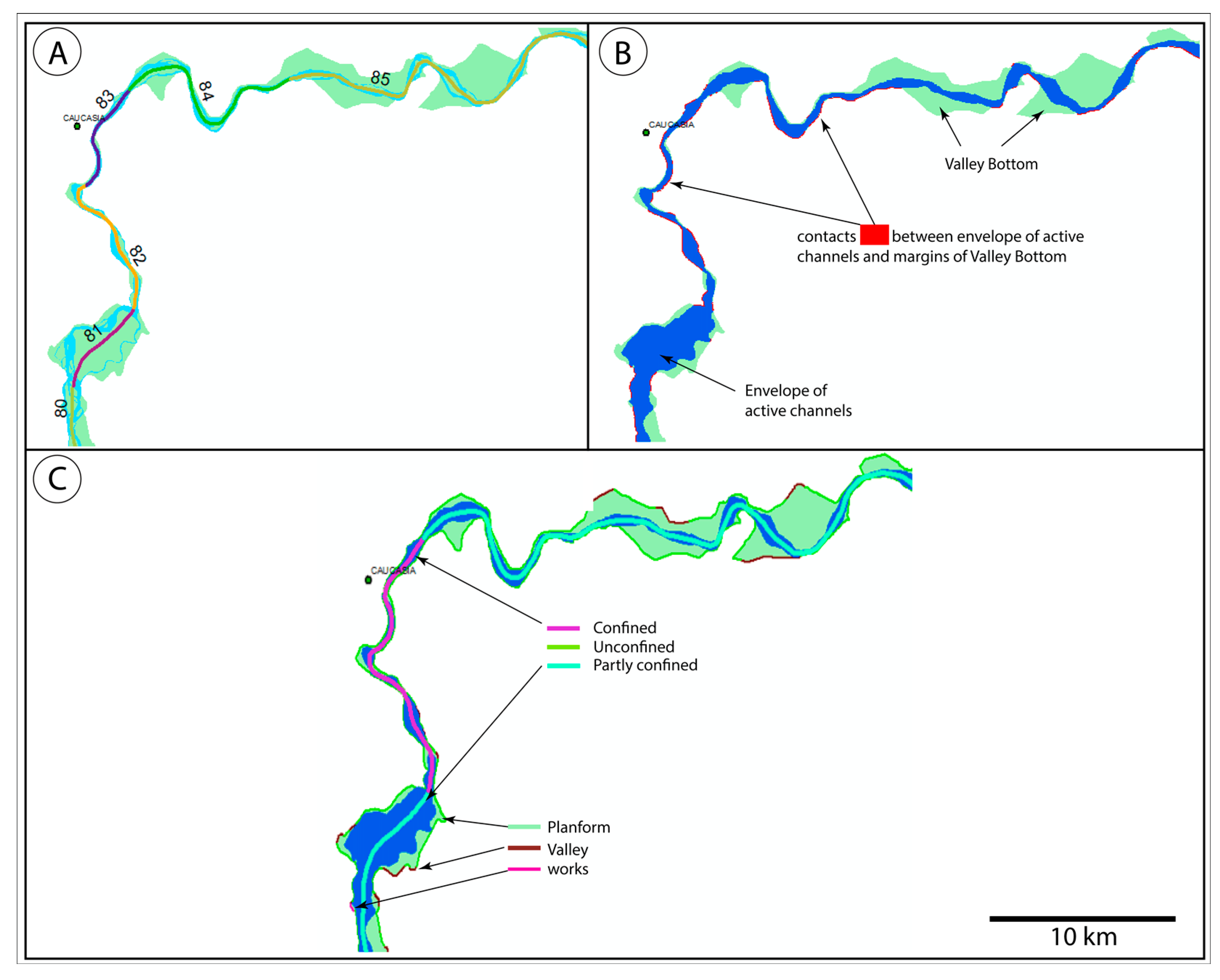
References
- Piégay, H.; Arnaud, F.; Belletti, B.; Bertrand, M.; Bizzi, S.; Carbonneau, P.; Dufour, S.; Liébault, F.; Ruiz-Villanueva, V.; Slater, L. Remotely sensed rivers in the Anthropocene: State of the art and prospects. J. Earth Surf. Process. Landf. 2020, 45, 157–188. [Google Scholar] [CrossRef]
- Brierley, G.; Fryirs, K. Geomorphology and River Management: Applications of the River Styles Framework; Wiley-Blackwell: Malden, MA, USA, 2005. [Google Scholar] [CrossRef]
- Carrivick, J.L.; Smith, M.W. Fluvial and aquatic applications of Structure from Motion photogrammetry and unmanned aerial vehicle/drone technology. J. Wiley Interdiscip. Rev. Water 2018, 6, e1328. [Google Scholar] [CrossRef]
- Fryirs, K.A.; Wheaton, J.M.; Bizzi, S.; Williams, R.; Brierley, G.J. To plug-in or not to plug-in? Geomorphic analysis of rivers using the River Styles Framework in an era of big data acquisition and automation. J. Wiley Interdiscip. Rev. Water 2019, 6, e1372. [Google Scholar] [CrossRef]
- Fryirs, K.A.; Brierley, G.J. Assessing the geomorphic recovery potential of rivers: Forecasting future trajectories of adjustment for use in management. J. Wiley Interdiscip. Rev. Water 2016, 3, 727–748. [Google Scholar] [CrossRef]
- O’Brien, G.R.; Wheaton, J.M.; Fryirs, K.; Macfarlane, W.W.; Brierley, G.; Whitehead, K.; Gilbert, J.; Volk, C. Mapping valley bottom confinement at the network scale. J. Earth Surf. Process. Landf. 2019, 44, 1828–1845. [Google Scholar] [CrossRef]
- Clubb, F.J.; Mudd, S.M.; Milodowski, D.T.; Valters, D.A.; Slater, L.J.; Hurst, M.D.; Limaye, A.B. Geomorphometric delineation of floodplains and terraces from objectively defined topographic thresholds. J. Earth Surf. Dyn. 2017, 5, 369–385. [Google Scholar] [CrossRef]
- Stout, J.C.; Belmont, P. TerEx ToolBox for semi-automated selection of fluvial terrace and floodplain features from LiDAR. Earth Surf. Process. Landf. 2014, 39, 569–580. [Google Scholar] [CrossRef]
- Wheaton, J.M.; Brasington, J.; Darby, S.E.; Sear, D.A. Accounting for uncertainty in DEMs from repeat topographic surveys: Improved sediment budgets. J. Earth Surf. Process. Landf. J. Br. Geomorphol. Res. Group 2010, 35, 136–156. [Google Scholar] [CrossRef]
- Bizzi, S.; Blamauer, B.; Braca, G.; Bussettini, M.; Camenen, B.; Comiti, F.; Demarchi, L.; Garcia De Jalon, D.; Gonzalez Del Tanago, M.; Grabowski, R. Thematic Annexes of the Multi-Scale Hierarchical Framework. Deliverable 2.1, Part 2 of REFORM (Restoring Rivers for Effective Catchment Management), a Collaborative Project (Large-Scale Integrating Project) Funded by the European Commission within the 7th Framework Programme under Grant Agreement 282656; European Commission: Brussels, Belgium, 2014. [Google Scholar]
- Bizzi, S.; Demarchi, L.; Grabowski, R.; Weissteiner, C.; Van de Bund, W. The use of remote sensing to characterise hydromorphological properties of European rivers. J. Aquat. Sci. 2016, 78, 57–70. [Google Scholar] [CrossRef]
- Casado, M.; Gonzalez, R.; Kriechbaumer, T.; Veal, A. Automated identification of river hydromorphological features using UAV high resolution aerial imagery. J. Sens. 2015, 15, 27969–27989. [Google Scholar] [CrossRef]
- Dalla Mura, M.; Prasad, S.; Pacifici, F.; Gamba, P.; Chanussot, J.; Benediktsson, J.A. Challenges and opportunities of multimodality and data fusion in remote sensing. J. Proc. IEEE 2015, 103, 1585–1601. [Google Scholar] [CrossRef]
- Demarchi, L.; Bizzi, S.; Piégay, H. Hierarchical object-based mapping of riverscape units and in-stream mesohabitats using LiDAR and VHR imagery. J. Remote Sens. 2016, 8, 97. [Google Scholar] [CrossRef]
- Demarchi, L.; Bizzi, S.; Piégay, H. Regional hydromorphological characterization with continuous and automated remote sensing analysis based on VHR imagery and low-resolution LiDAR data. J. Earth Surf. Process. Landf. 2017, 42, 531–551. [Google Scholar] [CrossRef]
- Nardini, A.; Yépez, S.; Rogeliz, C. Caracterización geomorfológica river styles en la Cuenca del rio Magdalena: Caso estudio Magdalena y caja de herramientas para la aplicación automatizada a la cuenca. GeoMagda ToolBox; The Nature Conservancy: Bogotá, Colombia, 2019; Available online: https://www.researchgate.net/publication/338585128_Manual_GeoMAGDA (accessed on 3 March 2020).
- Nardini, A.; Yepez, S.; Zuniga, L.; Gualtieri, C.; Bejarano, M.D. A Computer Aided Approach for River Styles—Inspired Characterization of Large Basins: The Magdalena River (Colombia). Water 2020, 12, 1147. [Google Scholar] [CrossRef]
- Nardini, A.; Yepez, S.; Mazzorana, B.; Ulloa, H.; Bejarano, M.D.; Laraque, A. Geomorphic river characterization: A systematic, automated approach for river segmentation with case studies on the Magdalena River (Colombia) and on the Baker River (Chile). Water 2020. submitted. [Google Scholar]
- Nagel, D.E.; Buffington, J.M.; Sharon, P.L.; Seth, W.; Goode, J.R. A landscape scale valley confinement algorithm: Delineating unconfined valley bottoms for geomorphic, aquatic, and riparian applications USDA For. Serv. Gen. Tech. Rep. RMRS-GTR 2014, 42. [Google Scholar] [CrossRef]
- Parker, C.; Clifford, N.J.; Thorne, C.R. Automatic delineation of functional river reach boundaries for river research and applications. J. River Res. Appl. 2012, 28, 1708–1725. [Google Scholar] [CrossRef]
- Harmar, O.P.; Clifford, N.J. Planform dynamics of the lower Mississippi River. J. Earth Surf. Process. Landf. 2006, 31, 825–843. [Google Scholar] [CrossRef]
- Davis, J. Statistics and Data Analysis in Geology; John Wiley and Sons: New York, NY, USA, 2002; p. 656. [Google Scholar]
- Webster, R. Automatic soil-boundary location from transect data. J. Int. Assoc. Math. Geol. 1973, 5, 27–37. [Google Scholar] [CrossRef]
- Bohling, G.; Doveton, J.; Guy, B.; Watney, L.; Bhattacharya, S. PFEFFER 2.0 Manual; Kansas Geological Survey: Lawrence, KS, USA, 1998. [Google Scholar]
- Gill, D. Application of a statistical zonation method to reservoir evaluation and digitized-log analysis. J. AAPG Bull. 1970, 54, 719–729. [Google Scholar]
- Hawkins, D.M.; Merriam, D. Optimal zonation of digitized sequential data. J. Math. Geol. 1973, 5, 389–395. [Google Scholar] [CrossRef]
- Hubert, P. The segmentation procedure as a tool for discrete modeling of hydrometeorological regimes. J. Stoch. Environ. Res. Risk Assess. 2000, 14, 297–304. [Google Scholar] [CrossRef]
- Martínez-Fernández, V.; Solana-Gutiérrez, J.; del Tánago, M.G.; de Jalón, D.G. Automatic procedures for river reach delineation: Univariate and multivariate approaches in a fluvial context. J. Geomorphol. 2016, 253, 38–47. [Google Scholar] [CrossRef]
- Roux, C.; Alber, A.; Bertrand, M.; Vaudor, L.; Piégay, H. “Fluvial Corridor”: A new ArcGIS ToolBox package for multiscale riverscape exploration. J. Geomorphol. 2015, 242, 29–37. [Google Scholar] [CrossRef]
- Feyisa, G.L.; Meilby, H.; Fensholt, R.; Proud, S.R. Automated Water Extraction Index: A new technique for surface water mapping using Landsat imagery. J. Remote Sens. Environ. 2014, 140, 23–35. [Google Scholar] [CrossRef]
- Xu, H. Modification of normalized difference water index (NDWI) to enhance open water features in remotely sensed imagery. J. Int. J. Remote Sens. 2006, 27, 3025–3033. [Google Scholar] [CrossRef]
- Monegaglia, F.; Zolezzi, G.; Güneralp, I.; Henshaw, A.J.; Tubino, M. Software Automated extraction of meandering river morphodynamics from multitemporal remotely sensed data. J. Environ. Model. 2018, 105, 171–186. [Google Scholar] [CrossRef]
- Carlson, T.; Ripley, D. On the relation between NDVI, fractional vegetation cover, and leaf area index. J. Remote Sens. Environ. 1997, 62, 241–252. [Google Scholar] [CrossRef]
- Bangen, S.; Kramer, N.; Wheaton, J.; Bouwes, N. The GUTs of the Geomorphic Unit Tool (GUT): What is under the hood. In Proceedings of the AGU Fall Meeting, New Orleans, LA, USA, 11–15 December 2017. [Google Scholar]
- Bangen, S.G.; Kramer, N.; Wheaton, J.M.; Bouwes, N. Mapping instream geomorphic units from high resolution topography. 2020; In preparation. [Google Scholar]
- Kramer, N.; Bangen, S.; Wheaton, J.M.; Bouwes, N.; Wall, E.; Saunders, C.; Bennett, S.; Fortney, S. Geomorphic Unit Tool (GUT): Applications of Fluvial Mapping. In Proceedings of the AGU Fall Meeting Abstracts, New Orleans, LA, USA, 11–15 December 2017. [Google Scholar]
- Gilbert, J.T.; Macfarlane, W.W.; Wheaton, J.M. The Valley Bottom Extraction Tool (V-BET): A GIS tool for delineating valley bottoms across entire drainage networks. J. Comput. Geosci. 2016, 97, 1–14. [Google Scholar] [CrossRef]
- Carbonneau, P.; Fonstad, M.A.; Marcus, W.A.; Dugdale, S.J. Making riverscapes real. J. Geomorphol. 2012, 137, 74–86. [Google Scholar] [CrossRef]
- Carbonneau, P.E.; Lane, S.N.; Bergeron, N.E. Catchment-scale mapping of surface grain size in gravel bed rivers using airborne digital imagery. J. Water Resour. Res. 2004, 40. [Google Scholar] [CrossRef]
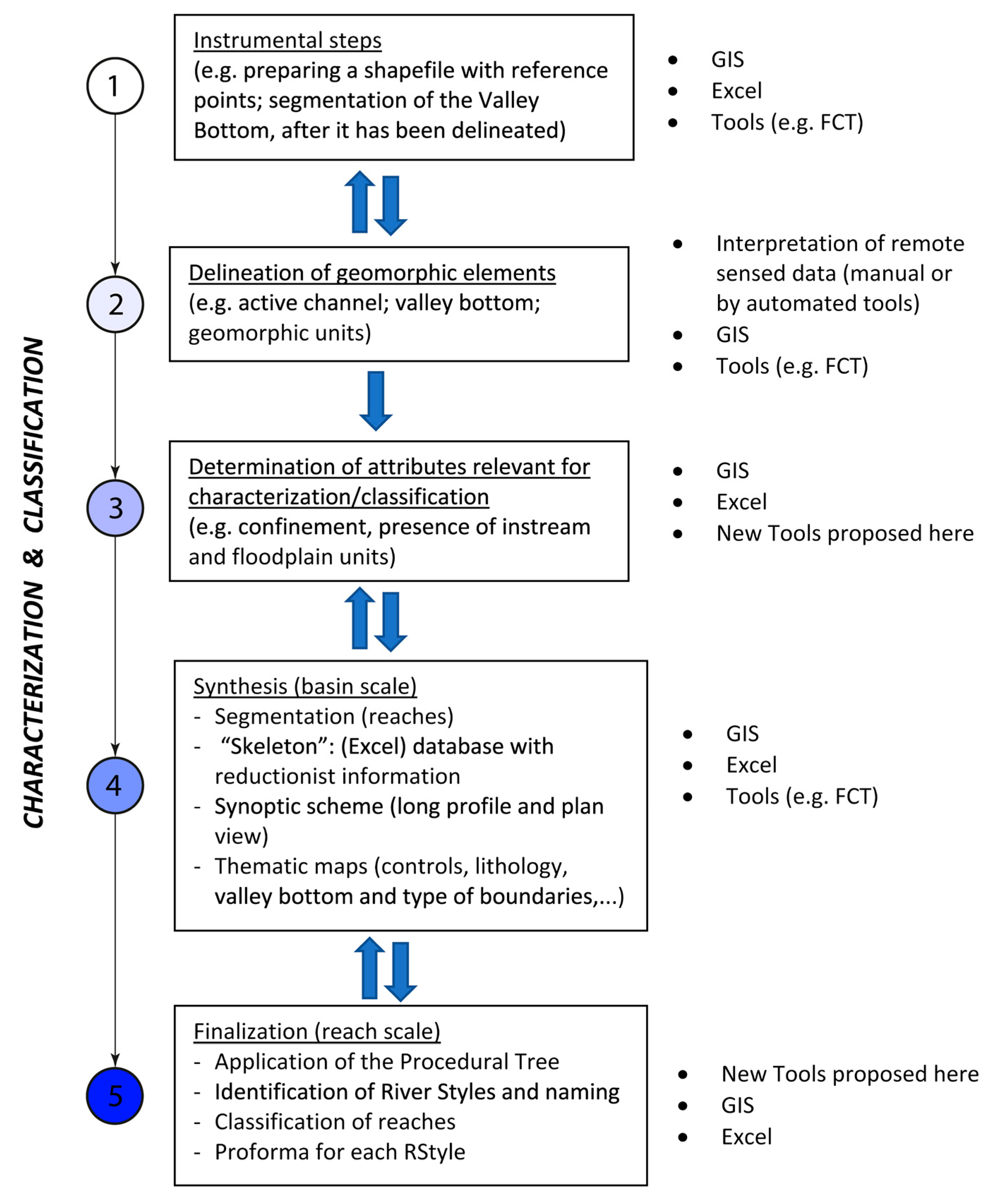
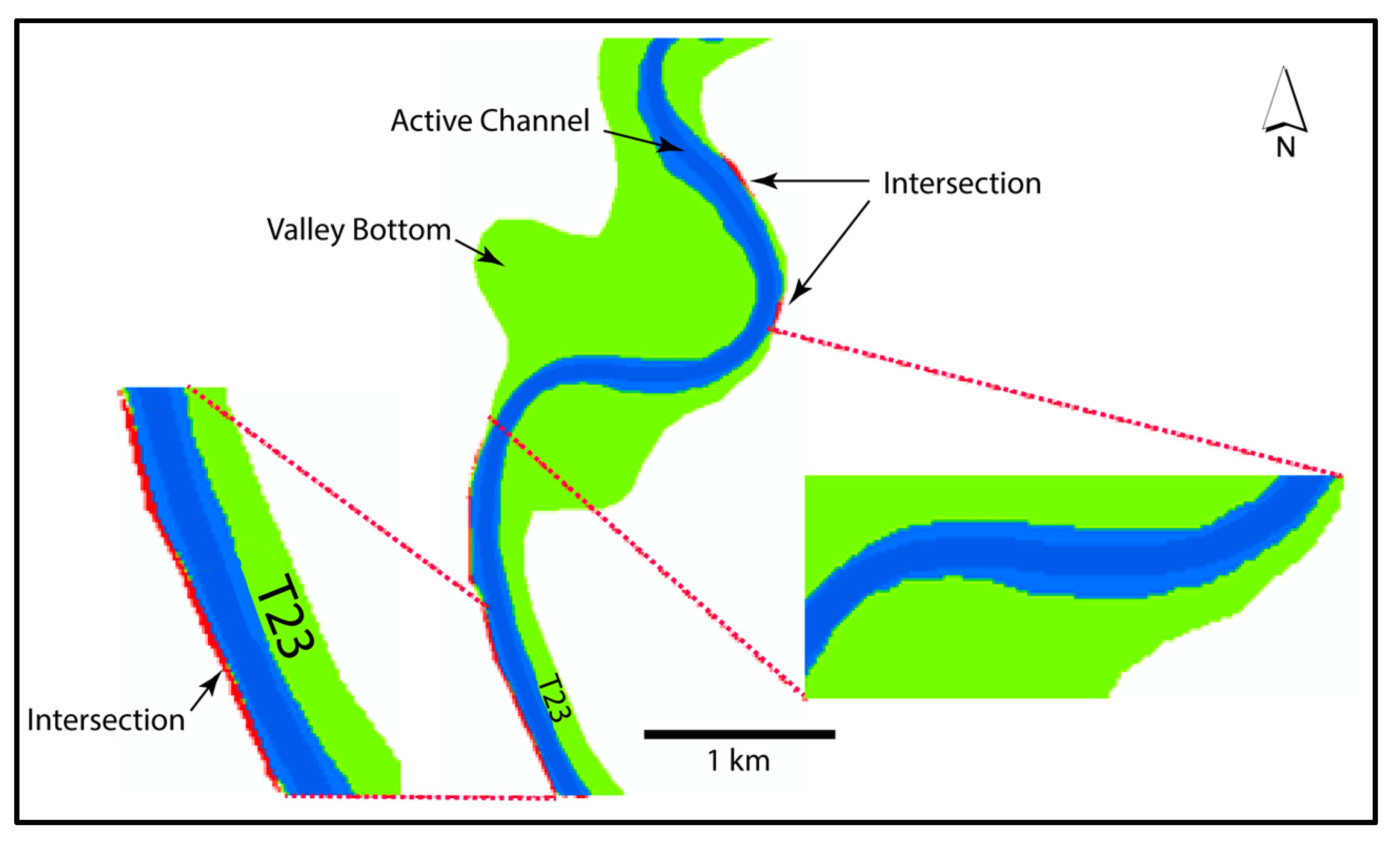
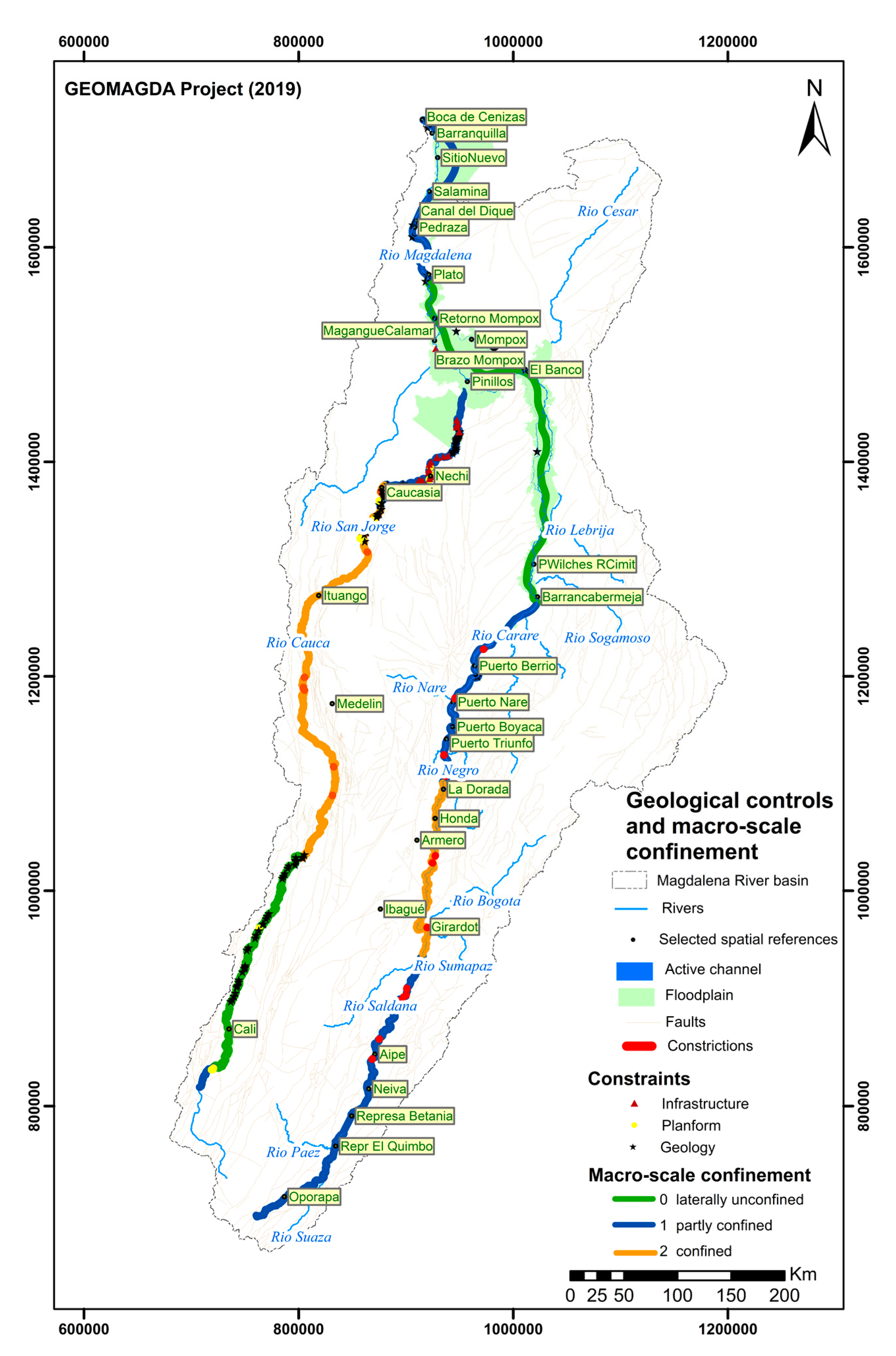
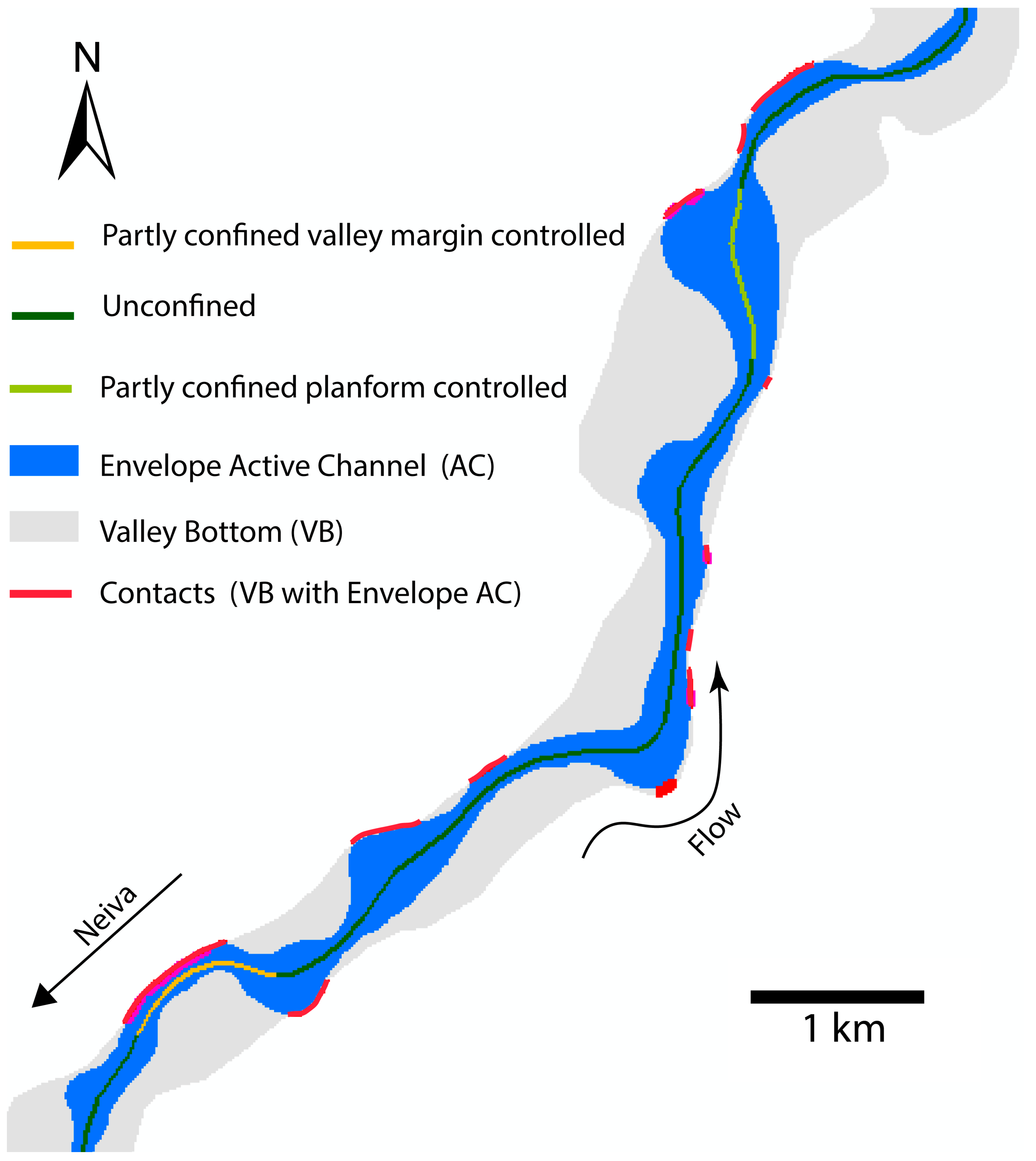
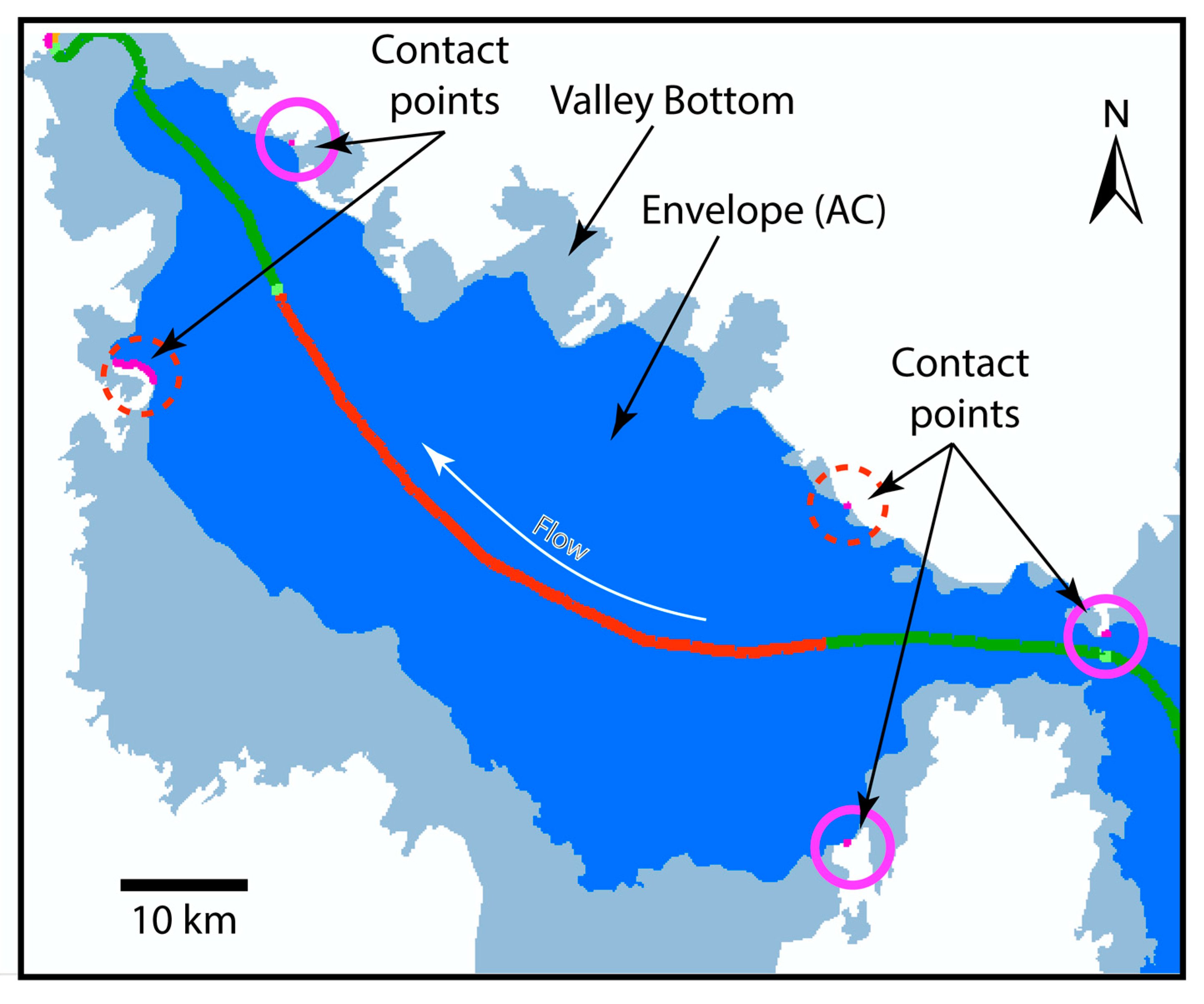
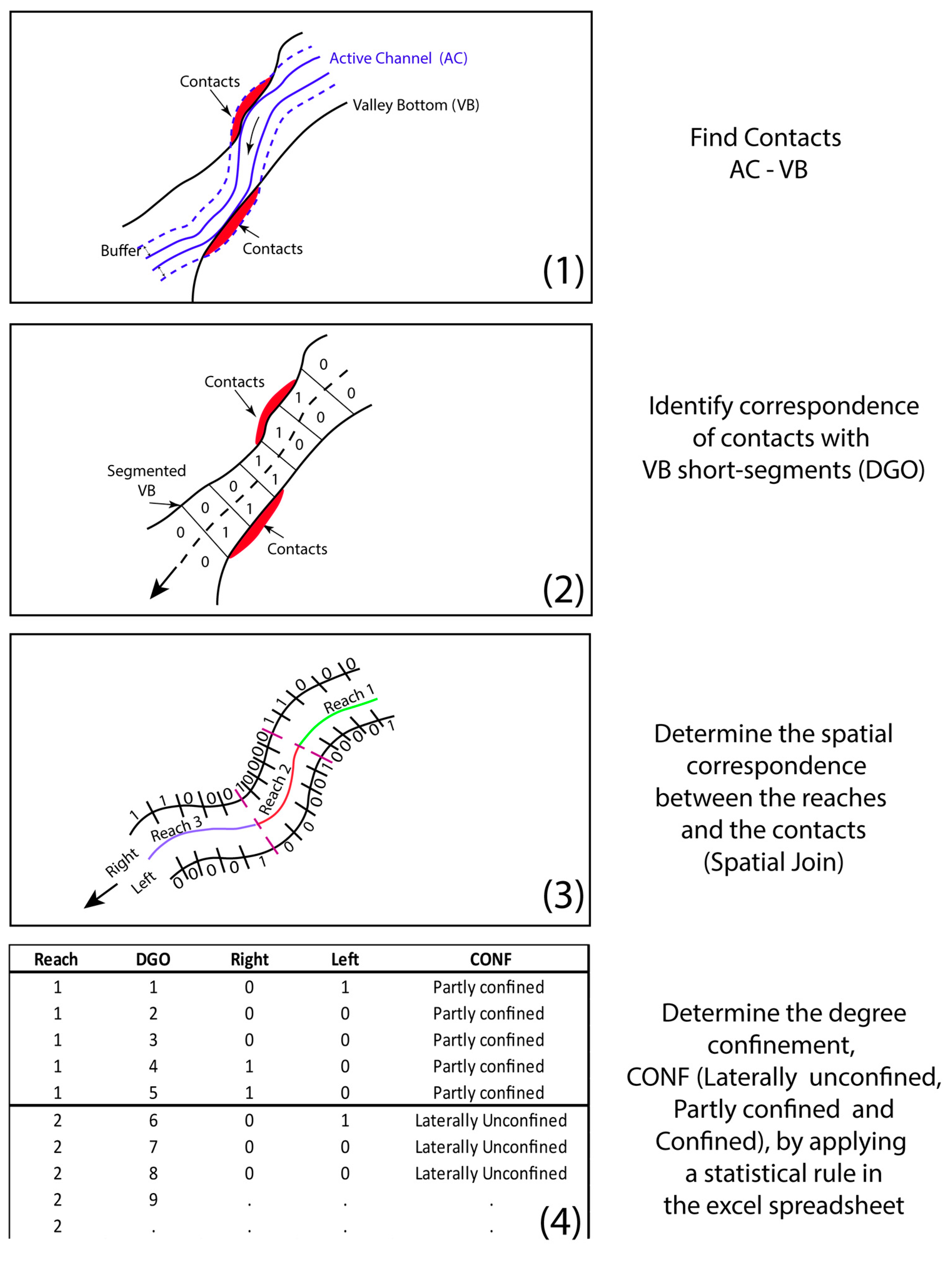
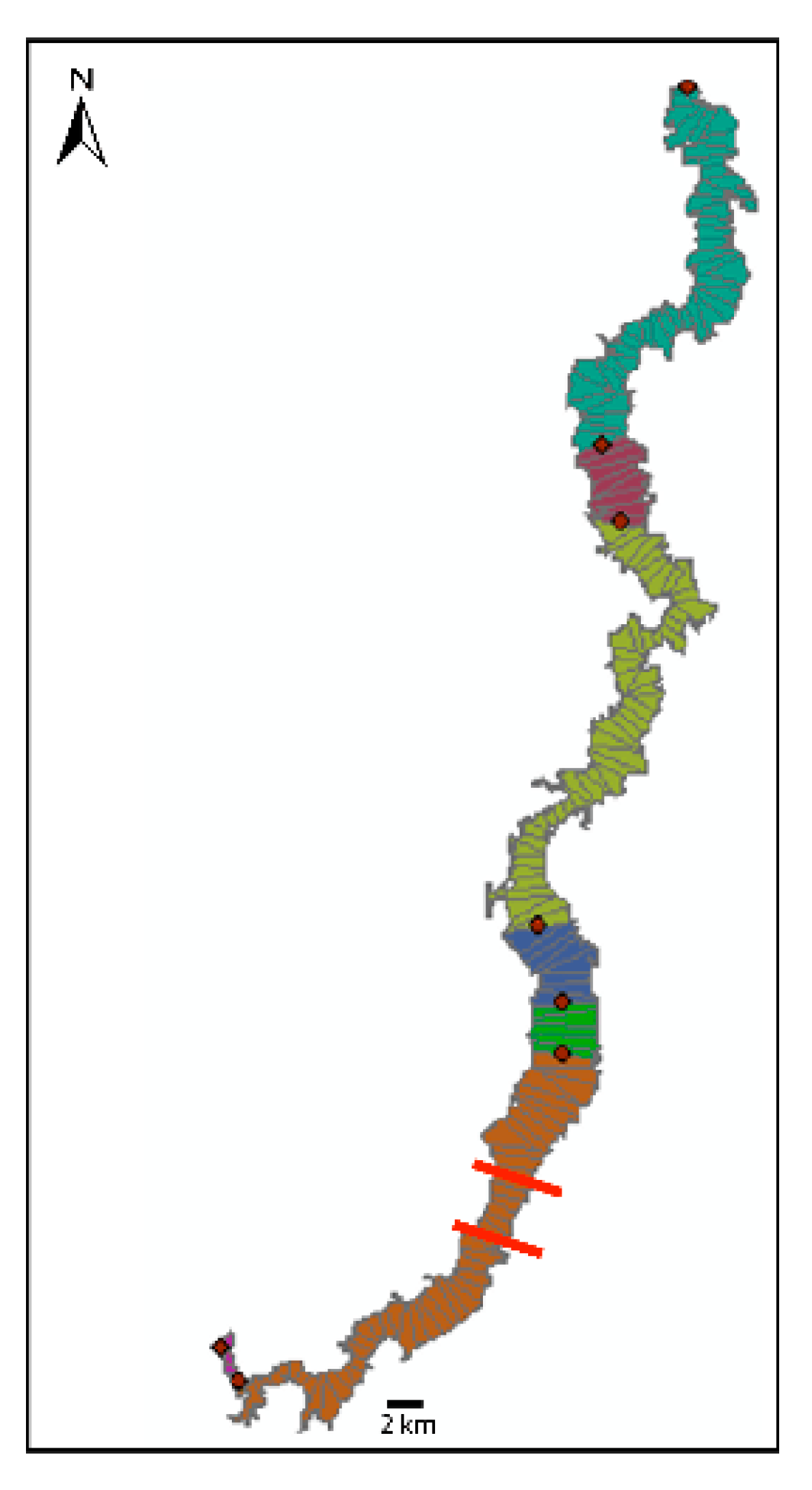
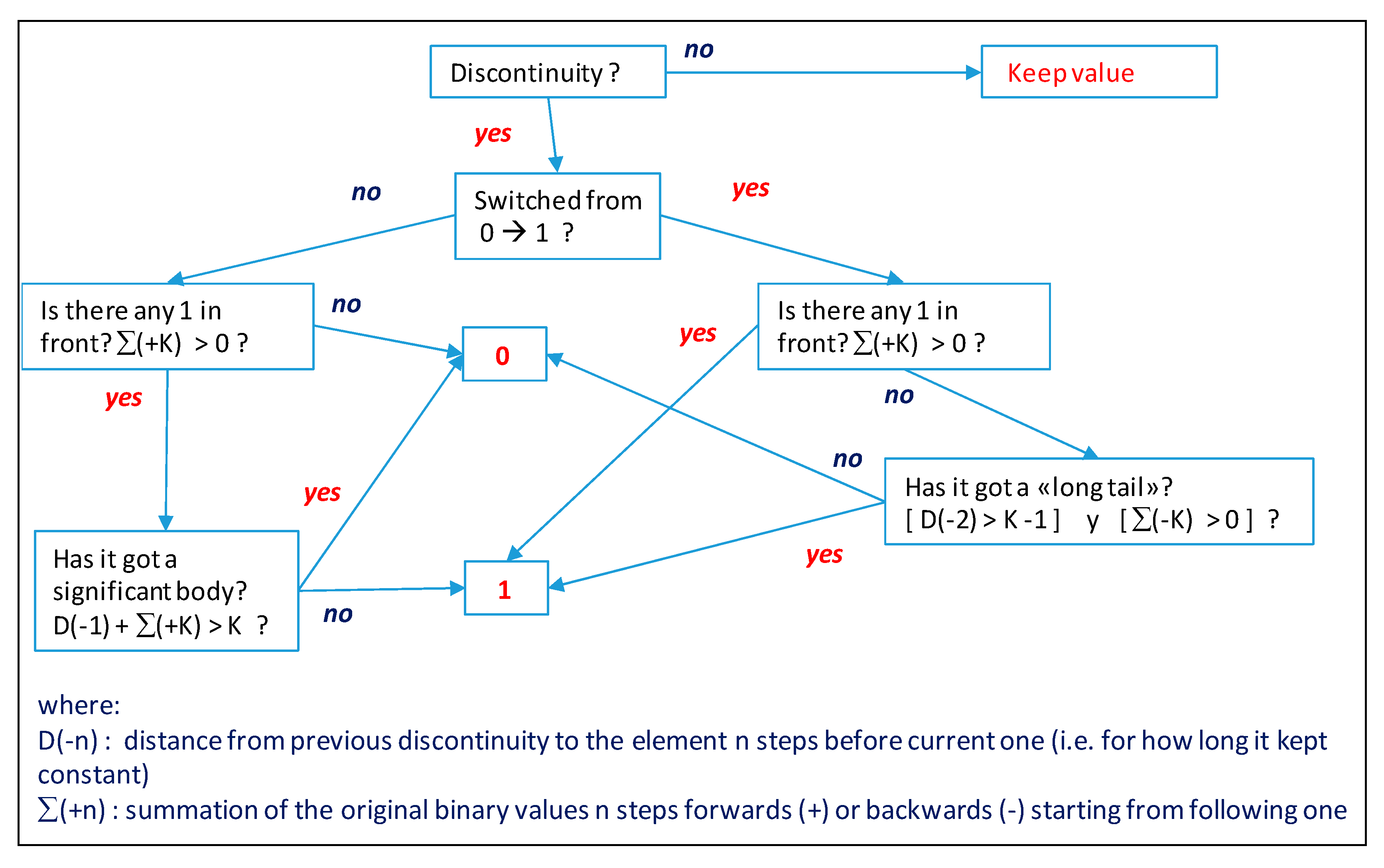
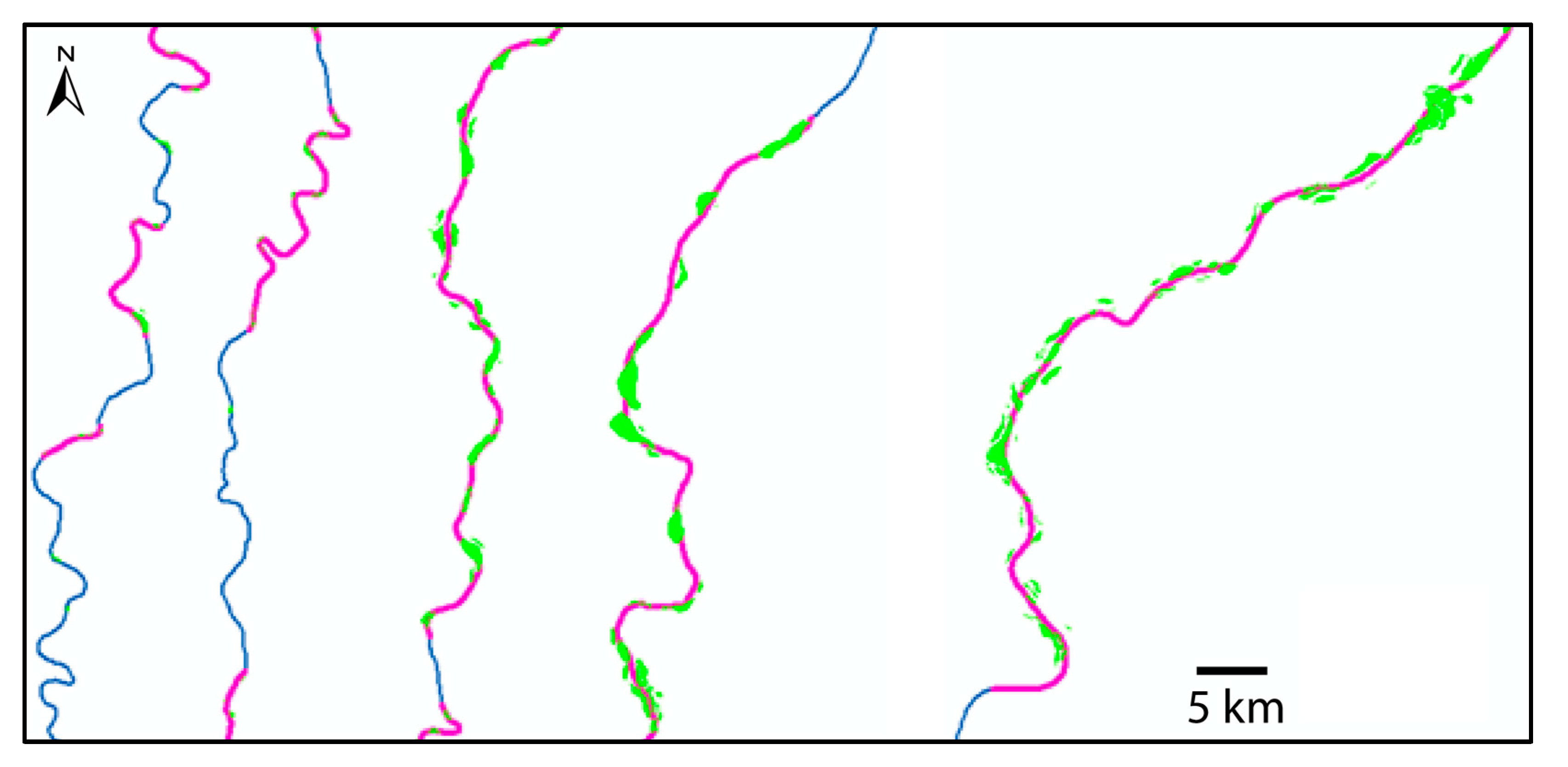
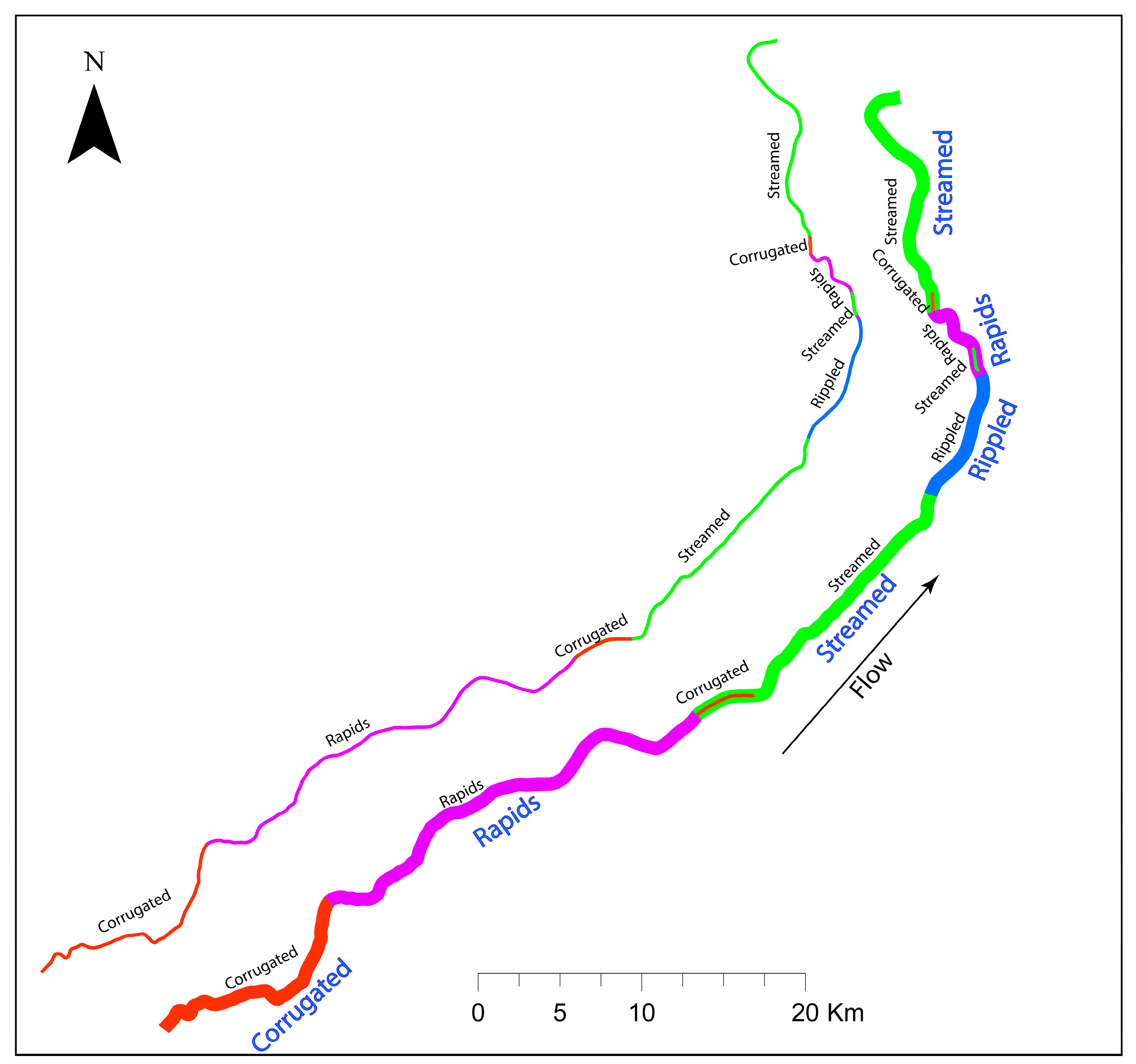
© 2020 by the authors. Licensee MDPI, Basel, Switzerland. This article is an open access article distributed under the terms and conditions of the Creative Commons Attribution (CC BY) license (http://creativecommons.org/licenses/by/4.0/).
Share and Cite
Nardini, A.; Yépez, S.; Bejarano, M.D. A Computer Aided Approach for River Styles—Inspired Characterization of Large Basins: A Structured Procedure and Support Tools. Geosciences 2020, 10, 231. https://doi.org/10.3390/geosciences10060231
Nardini A, Yépez S, Bejarano MD. A Computer Aided Approach for River Styles—Inspired Characterization of Large Basins: A Structured Procedure and Support Tools. Geosciences. 2020; 10(6):231. https://doi.org/10.3390/geosciences10060231
Chicago/Turabian StyleNardini, Andrea, Santiago Yépez, and Maria Dolores Bejarano. 2020. "A Computer Aided Approach for River Styles—Inspired Characterization of Large Basins: A Structured Procedure and Support Tools" Geosciences 10, no. 6: 231. https://doi.org/10.3390/geosciences10060231
APA StyleNardini, A., Yépez, S., & Bejarano, M. D. (2020). A Computer Aided Approach for River Styles—Inspired Characterization of Large Basins: A Structured Procedure and Support Tools. Geosciences, 10(6), 231. https://doi.org/10.3390/geosciences10060231







